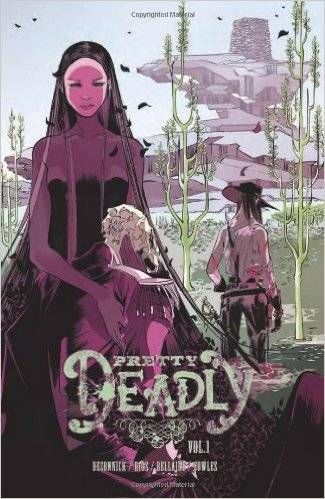
How Is This Book Violent? or How Violent Is This Book?
Trigger warning: as the title suggests, the following will be a discussion of violence in books and other media

I told my friend that Pretty Deadly was within my range of “acceptable” (for lack of a better term) violence. He then asked if I could rank it on a “acceptable violence” scale of 1-10 so he’d be better able to recommend things to me in the future (yeah, I have great friends). I struggled with answering his question for few minutes. Then I realized that I don’t have a 1-10 scale for these things. For me the answer is more complicated: more qualitative than quantitative.
The best way I can think to describe it is it’s is less like a single dial and more like a mixing board -the overall effect determined by the combination of the following different factors:
Graphicness
This one is pretty easy to understand. The longer and more detailed the descriptions or the more gruesome the image of violence or its effects, the more queasy I get. This one is rarely a deal-breaker on its own because usually I can just skim ahead or close my eyes and “noooooope” my way through it.
Tone
I can usually handle violence, even of the gory variety, better if the overall work is light-hearted and campy (think Rat Queens or Cabin in the Woods) as opposed to darker, more serious, and more realistic.
Victim
I am fairly certain I am not alone in strongly objecting to reading about or seeing violence against kids. And yeah, okay – pets. I am totally that person who lost her goddamn mind when Peanut the guinea pig was threatened in House of Cards and I wept at the fate of Manchee in The Knife of Never Letting Go. I generally find adult-on-adult violence easier to tolerate so long as the violence isn’t of a certain type (say, sexual) or charged by certain feelings (misogyny), both of which I’ll get to in a minute (see what I mean about these all intersecting?).
Type of violence
This is where we get close to what a fellow Rioter called “no-fly” zones. I find it extremely difficult to read or watch scenes of torture or sexual violence. Blinding is a personal phobia of mine. In general the type of violence I tend to be better able to handle is big, bloody battles or purpose-driven fight scenes (i.e. one character trying to get something or go somewhere facing off against another character trying to prevent them from doing so).
Feelings associated with the violence
This one is probably the most important and yet the most difficult to pin down but feelings associated with an act of violence have a huge impact on me. I find violence more difficult to handle when it is driven by anger, hatred, or the desire to cause suffering or demonstrate power. I hate cruelty of all stripes; for example, even though it is by far and away not his “scariest” or more violent work, Stephen King’s Needful Things got under my skin because everyone in it becomes so nasty.
Okay, so why am I writing this other than to give you a tour of the inside of my head (say hi to Amy Poehler for me)? Because I think it’s helpful to consider what we can and can not handle in our books and all media in broader, shades-of-grey way that is still tangible. I think it is helpful to have a framework for understanding how we feel about any difficult issue (I have one of these for sexism too): to think “How is this [violent]?” instead of “How [violent] is this?” I think the more we understand ourselves and our reading practices, the better able we are to find things we can enjoy – and the better we are able to source recommendations from our friends.













